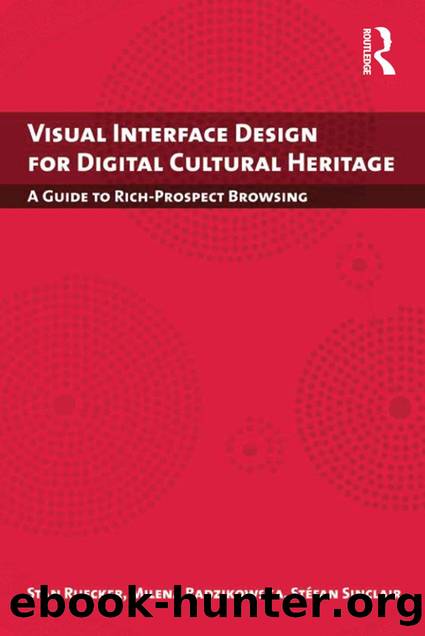Visual Interface Design for Digital Cultural Heritage: A Guide to Rich-Prospect Browsing (Digital Research in the Arts and Humanities) by Stan Ruecker & Milena Radzikowska

Author:Stan Ruecker & Milena Radzikowska [Ruecker, Stan]
Language: eng
Format: azw3
Publisher: Taylor and Francis
Published: 2016-02-16T16:00:00+00:00
Figure 4.2 Repetition Loops3
In rich-prospect browsing terms, the words are the representations, and the choice of repeated words or phrases chosen by the user are the means of manipulating the display. Rather than the affordance of grouping items, as shown in the Biodiversity Browser or the Mandala Browser, the visual organisation of the Repetition Loops is the combination of loops and spine.
Taking their inspiration from the Repetition Loops, two designs by Carlos Fiorentino employ still different approaches to meaningful representation. In this case, the interfaces visualise where search terms appear in multiple documents. In Bubblelines (Figure 4.3), the complete document is represented by a horizontal line – albeit a line that is significantly shorter than the lines used in Repetition Loops. Setting the horizontal lines in Bubblelines one above another does not provide any information about the absolute length of the documents, but it does show us their relative lengths in comparison with each other.
Download
This site does not store any files on its server. We only index and link to content provided by other sites. Please contact the content providers to delete copyright contents if any and email us, we'll remove relevant links or contents immediately.
Sass and Compass in Action by Wynn Netherland Nathan Weizenbaum Chris Eppstein Brandon Mathis(7402)
Drawing Shortcuts: Developing Quick Drawing Skills Using Today's Technology by Leggitt Jim(2532)
Hands-On Unity 2022 Game Development by Nicolas Alejandro Borromeo(2488)
The 46 Rules of Genius: An Innovator's Guide to Creativity (Voices That Matter) by Marty Neumeier(2311)
Autodesk Civil 3D 2024 from Start to Finish by Stephen Walz Tony Sabat(2288)
Rapid Viz: A New Method for the Rapid Visualization of Ideas by Kurt Hanks & Larry Belliston(2195)
Mathematics for Game Programming and Computer Graphics by Penny de Byl(2191)
Learn Qt 5: Build modern, responsive cross-platform desktop applications with Qt, C++, and QML by Nicholas Sherriff(2176)
Fusion 360 for Makers by Lydia Sloan Cline(1987)
Hands-On Neural Networks with Keras by Niloy Purkait(1881)
Taking Blender to the Next Level by Ruan Lotter(1869)
Express Your Creativity with Adobe Express by Rosie Sue(1846)
Mastering GUI Programming with Python by Alan D. Moore(1762)
Game Physics Cookbook by Gabor Szauer(1576)
Creative Character Design by Bryan Tillman(1557)
Unreal Engine 4 Game Development Quick Start Guide by Rachel Cordone(1436)
Hands-On GUI Application Development in Go by Andrew Williams(1427)
Qt 5 and OpenCV 4 Computer Vision Projects by Zhuo Qingliang(1409)
Mastering Graphics Programming with Vulkan by Marco Castorina | Gabriel Sassone(1391)
